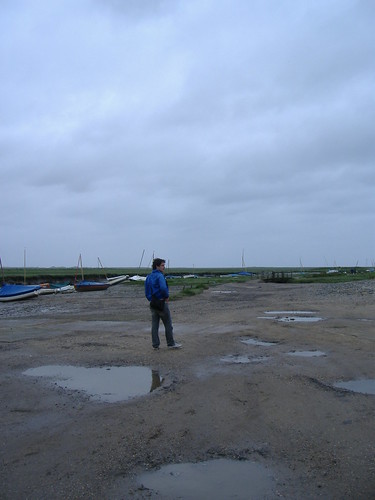Last summer I gave a paper on ghost stories, surrealism and the "paradoxically claustrophobic" exteriors of Thirties fiction at Sheffield Hallam University. It wasn't a particularly good paper- it was overlong and, in places, quixotic- but the weekend remains a pleasant memory for other reasons. Sheffield is a beautiful city when the sun shines, I enjoyed the hospitality of a good friend, had a top-class curry and watched England get knocked out of the world cup- thus curtailing the irritating hysteria of a bunch of beergutted part-timers- in the company of a former Rolling Stone journalist (I also met a man who worked for as a food scientist on the Campbells' Meatballs "brand", but that's another story. He reminded me of the guy in Wayne's World who sits at the bar of the donut cafe. Yes, the murderous one.)
I also met a girl who was studying for her PhD at Aberdeen under the supervision of Peter Davidson whose book The Idea of North got a fair few column inches in the review sections a year or so ago. Chatting to her prompted me to finally get around to reading it, and I was extremely glad I did: it's strangely wonderful. "Strangely" is qualitative here, because it's quite hard to judge the work as a success or failure due to the obscurity of its intentions: like the idea of north which Davidson tracks, the writing is curiously decentred. The Idea of North is the kind of text which I think of as bearing gifts without asking for anything in return. This is predominantly manifested in what amounts to an enormous reading-list of works which strive to articulate a phenomenology of "north"- spectres are a favoured theme for Davidson, and Merleau-Ponty's seems to haunt the book- as a geographic, climatic, linguistic and emotional entity.
Admittedly, TION is a little troubling in places. There is (depending on how generous one is willing to be) an either Wagnerian or Dungeons and Dragons-playing fixation with the intersecting mythologies of the (far) Northern hemisphere which does little to realign the idea itself. This is coupled with a tendency to reach for truisms: melancholy as the motivating force of the Northern imagination, summers without darkness, pine forests, Moomins. As a result of Davidson's obvious investments in these mythologies, one does come away from the book asking what "it" is, wondering if accounts of Inuit legend and "trouble at mill" really do anything more (in this context) than contribute to the "obfuscation of North".
Nevertheless, it is an enchanting work in which ambiguity- when not provoking the lapses of readerly faith I mentioned above- is elevated to the magical level of Symbolist suggestiveness (Munch is another slightly understated presence). It asks what a "literature of North" might be, and speculates as to whether the quintessentially "Northern" work would be able to engage with any straightforward form of realism. "North" has, from Mary Shelley through Virginia Woolf and through to the present day with Christopher Nolan's Insomnia (2002), been used in the figuration of extreme epistemological uncertainty. Setting a work within the Arctic Circle means that the traditional novelistic or cinematic time markers- darkness and light- become redundant in the seasonal absence of their inverses. Woolf's To the Lighthouse presents its characters as gradually slipping from the social map into either death or abstraction and the novel's "real world" setting- the Isle of Skye- is clearly strategically selected to contribute to this effect.
Genre fiction also plays with this idea of North. The Island of Sheep, the concluding novel in John Buchan's Richard Hannay cycle, presents the "Norlands" (presumably the Faroes or, at a push, Spitzbergen) as a place beyond the law in which ancient blood feuds still count. For M.R. James, the forests of Sweden were where one could go to awaken an ancient malevolence (see "Count Magnus", one of James' bleakest little numbers).
Last week I came across a novel which resolved many of my PhD issues- the representability of war, and the representation of loss as space- with Davidson's theme. Eric Linklater's The Dark of Summer ranges from the Faroes to Alamein, but is spiritually anchored to the various groups of islands off Scotland and Scandinavia. Its narrative engine (which is in some ways a MacGuffin) is driven by a plot supposedly operating under the aegis of Vidkun Quisling (Hitler's puppet leader in Norway) to ferment rebellion along the length of the Atlantic fringe and bring the Bretons, the Irish, the Hebrideans, Orcadians, Shetlanders and Faroese to the Axis cause. This is intercut- in a manner slightly reminiscent of W.G. Sebald- with the story of an 18th century feud between Shetland landowners, a descendant of whom is Quisling's ear in Lerwick and whose daughter eventually marries the spycatcher narrator.
Where The Dark of Summer corroborates Davidson's thesis is in its understatedness. Plot events are frequently played "off screen", such as in the case of the summary execution of the narrator's brother at Dunkirk which is never directly represented but always imagined. When this is not the case- such as when the narrator discovers a spy frozen to death in the outhouse of a shady Faroese poet- there is an absence of histrionics. The reader is constantly reminded that the narrator, like the protagonist of Insomnia, is operating in an exhausted condition at the absolute limit of his mental and physical faculties. Moreover, there is an ill-masked cynicism towards the postwar world which does not appear to be entirely confined to the narrator: this, in a way, is a novel about tiredness. One does not locate any centre other than a half-objectified "North" whose physical properties, as in Woolf, oscillate between tangible at-handness and ethereality. The novel is fascinated with both cultural and biological memory, with racial generalisation and with the preservability of historical identities: tellingly, it begins with the discovery of a 200 year-old corpse in a peat bog.
The Dark of Summer, in other words, attempts to sketch notes that differentiate essences from the mythologised absolutes of historical identity. In doing so, it predates the "historiographic metafiction" of Sebald, Ishiguro, Ondaatje et al which has been somewhat predominant in defining the recent literary scene. This alone makes it worth investigation, but it also offers a key to understanding (anglophone) imaginings of North which is in many ways indispensable. It probably belongs somewhere between Louis Macneice's I Crossed the Minch and Erskine Childers' The Riddle of the Sands on the bookshelf and so may be worth reading purely on the basis of the company it keeps.
Subscribe to:
Post Comments (Atom)



No comments:
Post a Comment